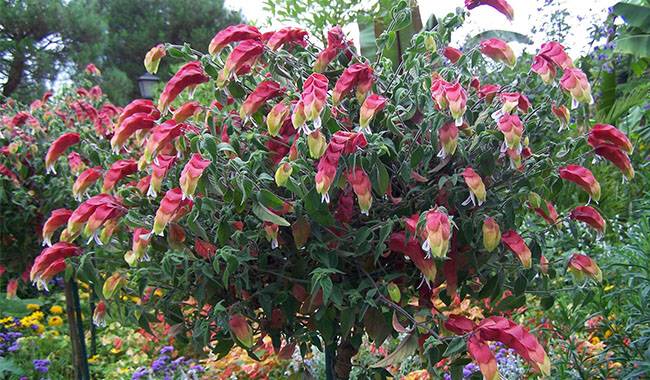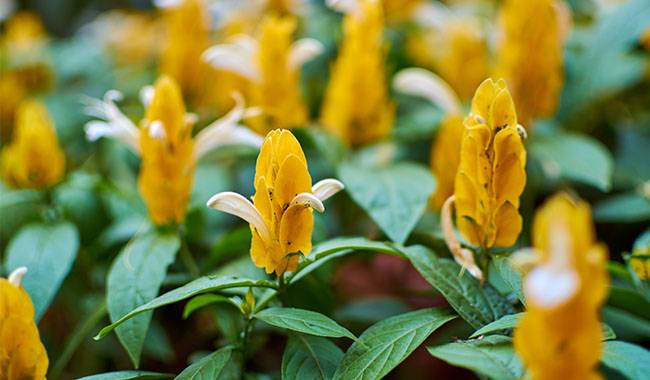
A representative of a group of plants whose bracts are far more attractive than the flowers themselves, Justicia Plant (Beloperone) seems to be a lush and colorful aristocrat. The hop cones add luster and layers to the plant, and the glossy foliage immediately draws the eye with its cloud-like effect. Justicia Plant has a more difficult temperament, but if you are looking for a consistently ornamental and unusual plant, then it is worth a closer look. Unfortunately, the botanical name “Justicia” has never really caught on with us because it looks so much like Justicia Plant.
DESCRIPTION OF THE INDOOR JUSTICIA PLANT
The endemic plant of Mexico, formerly Justicia Plant, now Justicia Plant (Beloperone), i.e., Justicia brandegeeana, obsolete synonym – Justicia fulvicoma, Beloperone guttata), never lost its status as a popular crop. Although beloperone has long been reassigned to the genus Justicia, its appearance has not become similar to that of Jacobinia Justicia. In Europe, Justicia Plant is still more commonly known as the old-fashioned way or room hops. In the West, it is more commonly referred to as Mexican shrimp week or shrimp week.
Justicia Plant is an evergreen, very dense shrub. Rarely reaching a height of 40 inches (1 meter) in a room, the size of the plant is largely determined by formation. The slender, pubescent, elongated shoots are densely packed and sometimes turn from straight to prostrate under a mass of leaves and inflorescences. The leaves with solid margins are also pubescent on the abaxial side with soft yellow hairs. Like the stems, they are set on fine petioles up to 1 inch (2.5 cm) long, less often clustered together. Oval or elliptic-lanceolate, 1-3 inches (2.5-7.5 cm) long, has a bright, saturated color with cream and white spots in some varieties.
The white, biconvex, narrow white flowers emerge from a series of broadly ovate bracts that completely cover them. The structure of the inflorescence is very similar to that of a hop cone. The pink, salmon, and orange-yellow bracts change color as they grow in an almost autumnal palette, from lettuce to yellow and orange-rust or from white to faded pink and dark red.
Bracts grow even after fading. The initial spikelets become increasingly long, up to 8 inches (20 cm) in length. Flowering continues almost year-round, in waves with brief pauses.
The Justicia Plant species for sale are more of a no-name. They are distinguished by the “finished” color of the bracts – yellow, cherry, pink, lettuce, and rust.
GROWING CONDITIONS OF JUSTICIA PLANT INDOORS

Justicia Plant is good in room form and in the office, where it looks good in halls and lobbies. The ideal combination of temperature and humidity is easier to reproduce in a greenhouse than in a room, but it will work if you want it to.
Lighting and Placement
Comfortable conditions for the White Justicia Plant can only be created on a well-lit windowsill. In a north-facing room, the plant will be underexposed, and in a south-facing window, it will receive direct sunlight in the summer. A west or east-facing window is still the best location for Justicia Plant. The light determines the quality of flowering.
It is best to treat it as a sun-loving crop in winter and protect it from the midday sun in spring and summer. Lack of light during the dormant period will cause the leaves to turn yellow.
Justicia Plant is a solitary plant that often gets lost in groups and looks unattractive. It should be allowed to disperse freely.
Temperature and Ventilation
Justicia Plant plants do not like the extreme heat and the excessive cold, with temperatures dropping below 55 °F (13 °C). Even in summer, it is best not to allow temperatures to exceed a stable range of 68-77 °F (20-25°C).
Justicia Plant prefers to winter in mild temperatures, and strong temperature drops cannot be tolerated – as low as 10 °F (-12 °C). Optimal feeding conditions are 59-64 °F (15-18 °C), up to -4 °F (-20 °C). Plants should not be exposed to excessive heat in the vicinity of heaters.
White Justicia plants should not be taken out onto balconies or gardens during the summer months and should always be in a protected environment, but should be ventilated as often as possible to prevent strong drafts (if windows are not constantly open).
CARING FOR THE JUSTICIA PLANT AT HOME
Justicia Plant’s love of high humidity is evident even in its watering. This is a plant that requires constant attention and will not tolerate any major mistakes.
Watering and Air Humidity
During warm periods, water only the top layer of the substrate until it dries out slightly, but control the humidity to avoid standing water and humidity in the tray. Even drying to half the depth of the pot can cause leaves and flowers to drop. Overwatering can cause a similar reaction.
During the dormant period, white peppers need to be watered gently. The best way to avoid drying out the substrate completely is to reduce watering by about half and dry out the soil a bit. If overwintering temperatures are above 64 °F (18°C), watering should be minimized, but the soil should still be allowed to dry out 0.4-0.8 inches (1-2 cm).
Comfortable air humidity is 60%, as plants will drop their leaves and shrivel in too dry an environment. To establish an optimal maintenance regime, you can spray during the warm season, but it is best to keep the plants constantly with a humidifier, or at least with a damp pebble tray. In the winter, the humidity can be slightly lower if kept cool.
You should use only water about 10°F warmer than room temperature for watering and spraying.
Fertilization and fertilizer composition
Justicia plants need to be fertilized frequently, but not too intensively. A standard fertilizer dose for flowering plants is sufficient for 2 weeks in spring and summer and 2 months in winter, but it is best to divide the fertilizer in half and apply once a week (once a month in winter). If possible, look for organic mineral fertilizers or alternate mineral and organic products.
Pruning and shaping Justicia Plant
With age, the loss of decorative qualities and the stripping away of the “bottom” of the Justicia Plant requires rejuvenating measures and regular heavy pruning to small stumps. To keep the plant compact for longer, shoots (showing growth) should be pruned each spring to encourage flowering and maintain a compact canopy. Prune one-third to one-half of the shoots in the normal manner.
Transplanting, containers and substrates
Young Justicia plants should usually be transplanted annually. Still, large and mature Justicia plants are best moved to new pots only when the entire substrate is full of roots and showing signs of overgrowth. The standard repotting frequency is 2-4 years. If repotting is not required in early spring, the top layer of soil should be carefully removed and replaced with a new substrate.
Classic containers with a height slightly greater than the width and large drainage holes can be used for growing Justicia Plant. It is not very fussy about materials, but in ceramic containers, it usually shows greater lushness. And it’s more stable: juicy and lush white plants will topple over on lightweight plastic pots.
When choosing a substrate, a very nutritious peat-free soil mixture should be preferred. The best response is a pH of 5.5-6.5. Soil-based on leafy soil with half of sand and sod soil has the best characteristics. The best commercial substrate choice is a fluoride-free substrate containing biological dormant for beautiful flowering plants. Coarse sand can be supplemented with perlite or other digesters, and a small amount of charcoal added to the substrate.
When planting Justicia Plant plants, it is best to keep the same immersion and transplant accurately, without exposing the roots and keeping the soil clods in place. Drainage in the bottom of the container is mandatory.
DISEASES, PESTS, AND CULTIVATION PROBLEMS
Justicia plants have more problems with improper conditions and care than with pests. Aphids, whiteflies, scale, and spider mites are dangerous if the air is dry, and they will not miss Justicia Plant if they appear on another plant in the house.
Insects can be controlled first with insecticidal plants (mugwort, marigold, pepper, onion husk, citrus essential oils), biological insecticides, and if natural products are not effective, chemical insecticides while strictly observing safety regulations.
DISSEMINATION OF JUSTICIA PLANT
This unique plant is propagated mainly by asexual reproduction. At home, it is best to root green, unbranched top plugs about 4 inches (10 cm) long, preferably cut in the latter part of winter and the first part of spring. After treatment with growth stimulants, shoots are rooted under mulch, in light soil, in a lower heating system at a temperature of 71-80 °F (22-27 °C). Several cuttings are planted per pot of plants.
Justicia Plant seeds are rarely available. However, if you get fresh seeds, you can plant them shallowly in a light substrate under glass or film. Keep the seeds at 68-77 °F (20-25°C) and gradually transfer them to larger and larger pots (only when the volume is full of roots).







